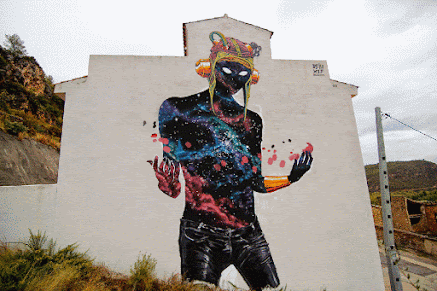Although it is hard to believe, the Japanese prefecture of Tokushima on the island of Shikoku, although still characterized by landscapes dominated by forests where abundant and almost unique are populated by endless forests of cedars, whose presence in virtually all of the island dating back thousands of years.
This situation has changed substantially due to the gradual abandonment of the serviculture, losing a good part of its enormous plantations, so that the sensation is that nowadays they are neglected cedar forests. This transformation of the landscape can be appreciated even more ostensibly as you go into the interior of the same, and you look a little in the abandoned remains of the sawmills that have been ceasing their activity in a staggered manner. One of the regions where it is best to observe how the change in the use of the territory can condition it, substantially altering its environmental balance.
It is where the locality of Kamikatsu is located, a village with an estimated population of only two hundred and fifty people, which around two thousand thirteen aroused great media interest mainly because its authorities had implemented a plan based on sustainable practices. By which it had been achieved that the almost one hundred and ten kilometers that covers its municipal term will receive the qualification of being considered the first municipality of all Japan to be labeled as Zero Waste or what is the same zero waste.
A meritorious recognition that would have been a mere anecdote if later and in the course of time, had not been carried out other types of actions aimed at consolidating the work done so far. And that had as objective to deepen in the respectful conducts with their environment. Such as the conservation of its natural heritage, as the region has many tributaries that mean that a diversity of species can have ensured their viability.
Policies that have had a very positive impact on the increase in the number of visitors, undoubtedly attracted by its recreational offer based on the organization of outdoor activities. Increase of public that on the one hand has meant a consirable increase on the part of many families in the area. Numerous businesses have opened, which has meant an economic revitalization for a region that after the dismantling of the sawmills had fallen into a severe economic depression.
But on the other hand, it also presented its uncertainties, mainly with the capacity of the waste treatment system, a fact that finally took place, exceeding all expectations. This forced the authorities in principle to transfer surpluses to other nearby locations, a temporary measure that finally came into force thanks to the recent entry into operation of the innovative and environmentally friendly waste plant in the region.
An event that in principle should not be news but in the case of the facilities that house the waste treatment and management plant has been built using recycled materials, a fact that might seem of minor importance or secondary. But objectively analyzed it has its merit. Because almost all of these types of facilities are usually built with public money, so the possibility of using materials other than those stipulated by law is rarely contemplated.
Designed by architect Hiroshi Nakamura, the recycling plant was conceived as a construction model using waste products, which after selection were optimized according to the part of the building where they were to be used. Although the horseshoe-shaped building's façade, consisting of no more and no less than seven hundred windows, stands out.
The waste treatment plant in the Japanese town of Kamitkatsu, built with recycled materials, invites us to reflect on our consumption habits and our relationship with our environment.
Collected in a record time of no more than a week, they were generously donated by local residents. The unprocessed wood and decorative ornaments that link the neighbors to the facility structure the building and form mobile volumes, were designed to be dismantled and reused if necessary.
Terrazzo made of glass and ceramic fragments runs the length of the center, and maintenance units made from bright blue storage containers were used to store tools for easy identification.
The recycling center provides a focal point for recycling activities and allows neighbors to share their ideas and values with visitors. They can tour it and see how it works on site. To that end, the studio was asked to include an auditorium as well as a recycled products store and a community activity space.
Kamikatsu Zero Waste Center incarnates the principle of zero-emission waste as a complex and environmentally friendly facility. Its conception is not limited only to treating the tons of waste generated each year by residents. It brings together a series of tools and spaces designed to raise awareness among citizens and users who benefit from the plant.
Thus, apart from the administration offices, which are separate from the plant, there is an education center and a research and communication department. Where the investigation staff in charge of its management is dedicated to developing new, more efficient and cleaner techniques related to recycling and waste disposal.
It is only visible from a zenithal position but the set of buildings that make up the plant represent a question mark. This is a symbolic act intended to encourage the user/consumer to question their consumption habits and lifestyles.
Opened in 2021, this is not an isolated project in the long career of architect Hiroshi Nakamura, who received his doctorate from Meiji University's Graduate School of Science and Technology in 1999 and worked for Kengo Kuma & Associates before founding his eponymous studio in 2002.
His projects aim to build an organic relationship between architecture, nature and the people who will reside in his buildings or be their users at some point in their lives. He observes this through an approach that combines influences from natural phenomena as well as human behavior.
Hiroshi Nakamura's architecture follows patterns observed in nature, with which the architect's designs try to establish as fluid a dialogue as possible.
There are many precedent projects that could be mentioned, but I have selected two of them according to what I consider to be their most identifiable architectural characteristics. The first one I am going to review is an unfinished project. Called Unknown Hill, built on the coast of Kujukuri which presents a landscape which highlights its undulating fields of grass.
Not wanting to damage this beautiful environment, He conceived the idea of raising a portion of the land, as if lifting the green carpet and using the space below as space for the building. The result is a building with an open and magnanimous appearance, where lying on the roof means lying on the ground. The boundaries between architecture and landscape dissolve, and a new relationship between nature and architecture emerges.
In the second project Hayama Cave of 2013. This vacation home sits on a cliff along the ocean. Because the site was on a steep slope and posed the danger of landslides, the choice was made to embed a reinforced concrete structure. The volume above was then built in the form of a round rock that would prevent the ground from sliding down the cliff.
The result is a space that blends into the landscape in a natural way. Once inside, a staircase leads into the interior of the cave, causing an echo effect so that sounds bounce instantly from top to bottom, as well as from left to right. This gives you the opportunity to feel truly isolated and in communion with the essence of nature which floods everything around you.








_edit_188822180547080.png)
_edit_8099193296908.jpg)









.jpg)





